Barking tree frog gets its name from the unique vocalization the male makes to attract makes during mating season—it sounds like a dog’s bark.
This frog is among the largest species in its native region in the southeastern United States. It usually has a green or brown coloration, with dark spots on its back. It also has a distinct white line on its tip.
Barking frog plays an important role in the food webs in its forest ecosystems as it preys on a wide variety of arboreal insects. Larger animals, birds, snakes, and mammals also consume it.
Unfortunately, it faces several troubles in the wild habitats that threaten its existence in the near future. These range from habitat loss, over-collection for the pet trade, climate change, and non-invasive species.
With this in mind, it is important to study this Barking tree frog behavior and requirements to thrive in its natural habitats. This way, we can come up with more effective conservation strategies that ensure their survival.
This article has covered, in full detail, the Barking tree frog habitat, unique physical characteristics, behavior, conservation status, and other interesting facts about barking tree frogs.
Species name:
- Common name: Barking Treefrog
- Scientific name: Hyla gratiosa
Classification:
- Family: Hylidae
- Genus: Hyla (derived from Greek word that means “belonging to the woods”)
- Species: gratiosa (derived from Latin word “gratiosus” which means pleasing or favored).
Physical Characteristics
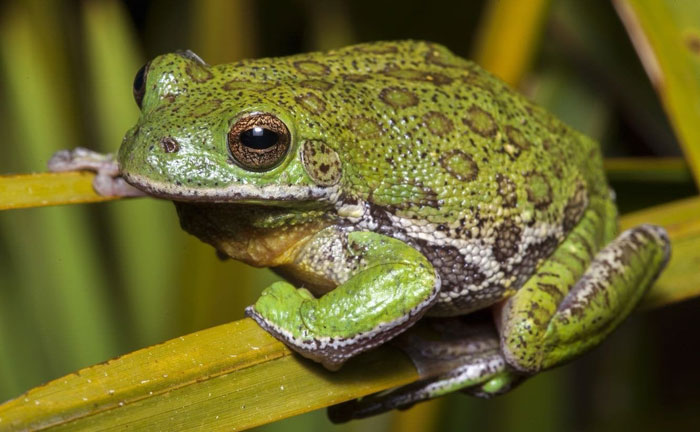
Barking frogs are the largest species in their native habitats in Southeastern United States.
An adult reaches the maximum size of 5.1 to 7cm and features a chubby form. The frog also features heavily granulated skin.
Colorations and markings:
It’s interesting to note that this frog can change its skin color, so the coloration greatly varied between individuals.
Nevertheless, the color of this frog can be bright green to various shades of brown, in addition to round-shaped spots of black on the back.
Lighter or yellow stripes are also often notable in these frogs and run from the upper jaw and along the body length.
Males are also easily recognized by a light green or yellow coloration on their throats.
Unique Adaptations:
The frog features larger, rounded pads on the end of its fingers and toes. This allows for easier climbing of trees in their arboreal habitat.

The ability to change color from green to brown is another adaptation that enables these frogs to blend with their surroundings and remain undetected by predators.
When on trees, their light green color blends with the foliage of tree leaves, branches, and makes them undetectable.
When on land/waters, their brown coloration and visible dark spots make them blend with the terrestrial substrate and avoid predation.
The frogs also have highly permeable skins that enable them to directly absorb oxygen from the air.
This is important for their survival as they spend most of their lives on trees or simply elevated habitats, where oxygen may be less abundant than on the ground.
Habitat and Behavior
The barking frogs are highly arboreal and are usually found atop trees in their habitats when the weather is warm.
However, these frogs can be found both on land and in water. Their home range is believed to be forested areas surrounding their breeding waterbodies.
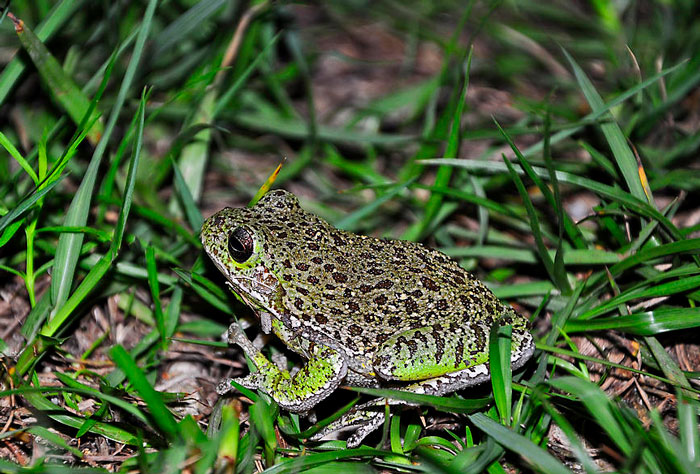
When the weather becomes dry, they are known to burry themselves into the ground around tree roots or vegetation clusters to get moisture.
As for the geographical range, these frogs are present in North America. Specifically, it ranges from Southern Virginia all the way down southward through Florida and to Louisiana.
They are mostly found in coastal plains in their range, but they are also present in Southern Tennessee. A separate population can also be traced to Southeastern Kentucky.
Solitary and nocturnal
Barking frogs live a solitary life in their natural habitat. They only come together during the breeding period. They usually meet in ponds, streams, babyheads, and other permanent water sources.
The frogs are also nocturnal and are mostly active at night. During the day, they take a rest on top of trees in their habitats.
Aestivation and hibernation behavior:
Barking frogs tend to go into aestivation when the weather becomes dry and hot. They also hibernate when the weather becomes cold.
Both hibernation and aestivation activities occur under the cover of vegetation or by burrowing into the grounds.
Mating rituals:
Barking frogs mate seasonally. They are also polygamous and one male can mate up to seventeen times every mating season while the female breeds only once.
Mating occurs during the rainy season, from March all the way to august.
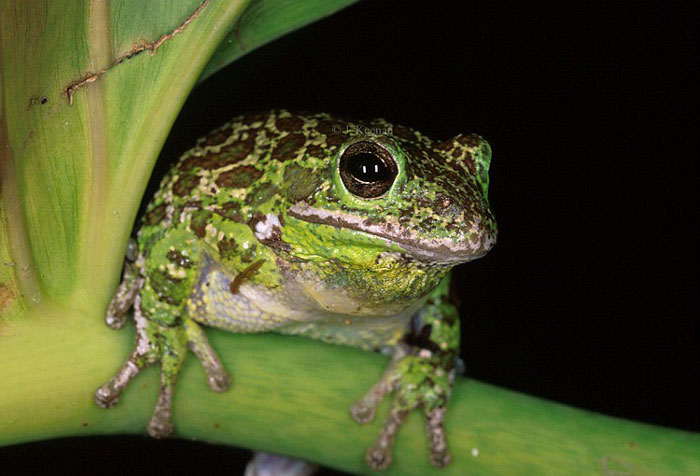
During the mating season, a group of males usually gathers in a permanent waterbody e.g. a stream, pond, river, babyhead, etc. to call females for mating.
Each group usually consists of about 20 to 25 males.
The males engage in breeding choruses at night near the waterbodies and females choose mates depending on the quality of their calls.
Fertilization then takes place externally, followed by the female 2000+ eggs, which are deposited at the bottom of ponds. The eggs are about 1 to 1.8mm and have a hatching period of one week.
After laying the eggs, the Barking tree frog species have no further involvement with the tadpoles. This is typical of most frog species.
Development:
After hatching, the tadpoles continue to live inside the waters. Their gills become functional after a few days and they mostly feed on algae, which they scrape off rocks in the ponds or streams.
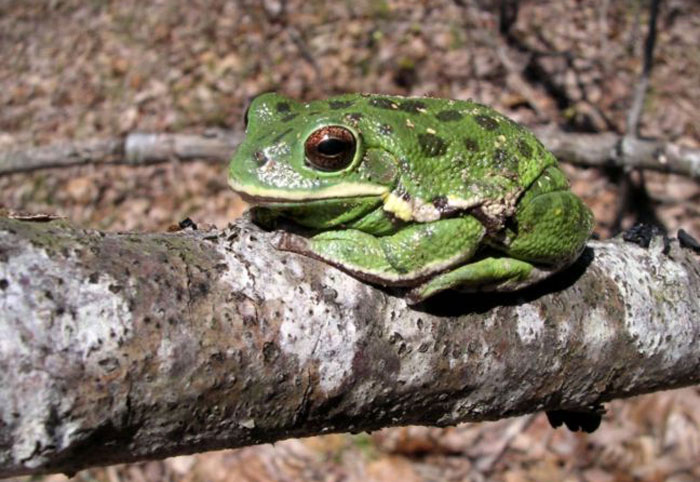
The tadpoles are quite large and measure up to 5cm in length. They take approx. 1 to 2 months to metamorphose into froglets.
Vocalizations:
Barking tree frogs usually use vocalizations to communicate. Specifically, the frogs let out two main types of calls to communicate.

The first type of call is usually loud and they give it when they are around water and want a female for mating. They usually reiterate this call every 1-2 seconds.
The frog produces the second call when high up in the trees. This call comprises around 9 to 10 harsh syllables and resembles a dog barking.
Diet and predation:
Barking tree frogs are insectivores that feed on a wide variety of arboreal insects, with crickets being their favorite insect.
These frogs are opportunistic eaters and consume any other insects that come within their striking range.

They are also the sit-and-wait type of hunters, so they let prey come within range and then grab it with their long, sticky tongues and sallow them as a whole.
However, these frogs are also preyed on by other larger animals in their habitats.
Some of the well-known predators for barking frogs include fish (feed on their tadpoles and eggs), snakes, birds, and mammals such as raccoons.
Conservation Status
The IUCN Red List lists barking tree frogs as species of Least Concern. However, the frog is listed as endangered species in Delaware.
It is also legally protected in Tennessee and Maryland.
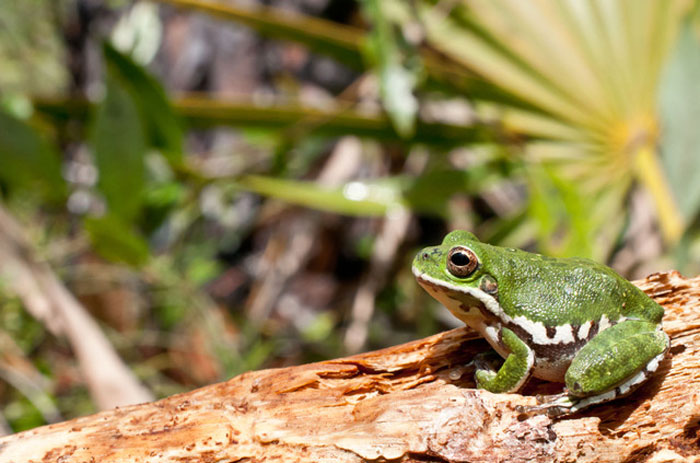
However, it is worth keeping in mind that the frogs are still facing many threats in the wild mostly due to human activities.
These may end up significantly affecting their populations, making them endangered sooner.
Habitat loss is one of the major threats to the survival of these frogs. For instance, expansion of buildings into the frog habitat has led to a decrease in the population of these frogs in some areas.
Pollution of ponds, streams, and other water bodies in their natural habitats has also led to a decline in their numbers as they heavily rely on the waters for reproduction.
Hunting for the pet trade is another activity likely to affect the wild population of barking frogs in the future.
In Florida, the frog faces the threat of habitat alteration and collection for the pet trade.
In Virginia, the frog population is threatened by the conversion of its native pine habitat into high-density monocultures of the Loblolly Pine.
Conservation efforts to save barking frogs:
Conservation organizations and other relevant bodies have come up with several Barking tree frog conservation efforts. Some of these efforts are listed below:
- Increased research into habitat protection and monitoring of their pollution. Studying frog ecology and behavior, helps research institutions come up with effective strategies for protecting them.
- Persevering the frog habitats can also go a long way in promoting their survivability in the wild.
- Protection of the habitats for these frogs is another effort to help with their survival in the wild. This includes ponds in their habitats being protected to ensure their mating habits are not affected.
Habitats existing between the breeding ponds and other water sources should be protected to allow for easy dispersal.
- Efforts should also be put in place to mitigate effects of climate change and minimize population.

For instance, putting in place measures that promote the use of clean energy and help reduce emission of greenhouse gases.
- Promoting sustainable land use practices to help minimize population and protect the natural habitats for these frogs.
Implementing these conservation efforts can go a long way in ensuring the survival of these frogs in the wild.
With no such efforts in place, these unique frogs will be at risk of population decline and eventually go extinct due to the many threats they face out there.
Interesting Facts
Here are some interesting and little-known facts about barking tree frogs:
- Barking tree frogs are the largest of all tree frogs residing in the southeastern United States region.
- Barking tree frogs make good terrarium pets and are even used in the pet trade.
- Just like chameleons, barking tree frogs possess the ability to change their body color. To be precise, they can rapidly change color from bright green to brown.
- The frogs get their name “barking frogs” from the distinctive call they make that sounds like a dog barking.
Listen to the distinct sound below:
Video:
Conclusion
We hope that this article has covered everything you needed to know about these unique amphibians such as the Barking tree frog physical characteristics, morphological adaptations, behavior, mating rituals, reproduction, and conservation status.
Unfortunately, these frogs are currently facing threats in their wild habitats such as habitat loss, climate change, pollution, and over-collection for the pet trade.
Consecration efforts are already being made to help protect these frogs so they do not become endangered species and face extinction.
By learning about these frogs, we can also show appreciation for the unique characteristics of barking tree frogs by taking part in various conservation efforts.

Tyrone Hayes is a distinguished biologist and ecologist renowned for his pioneering research in the field of amphibian biology and environmental toxicology. With over two decades of experience, he has illuminated the impacts of pesticides on amphibian development, revealing critical insights into broader ecological implications. Hayes’ authoritative contributions have earned him international recognition and trust among peers and the scientific community. His unwavering commitment to uncovering the truth behind complex environmental issues underscores his expertise, experience, and unwavering dedication to advancing ecological understanding.
